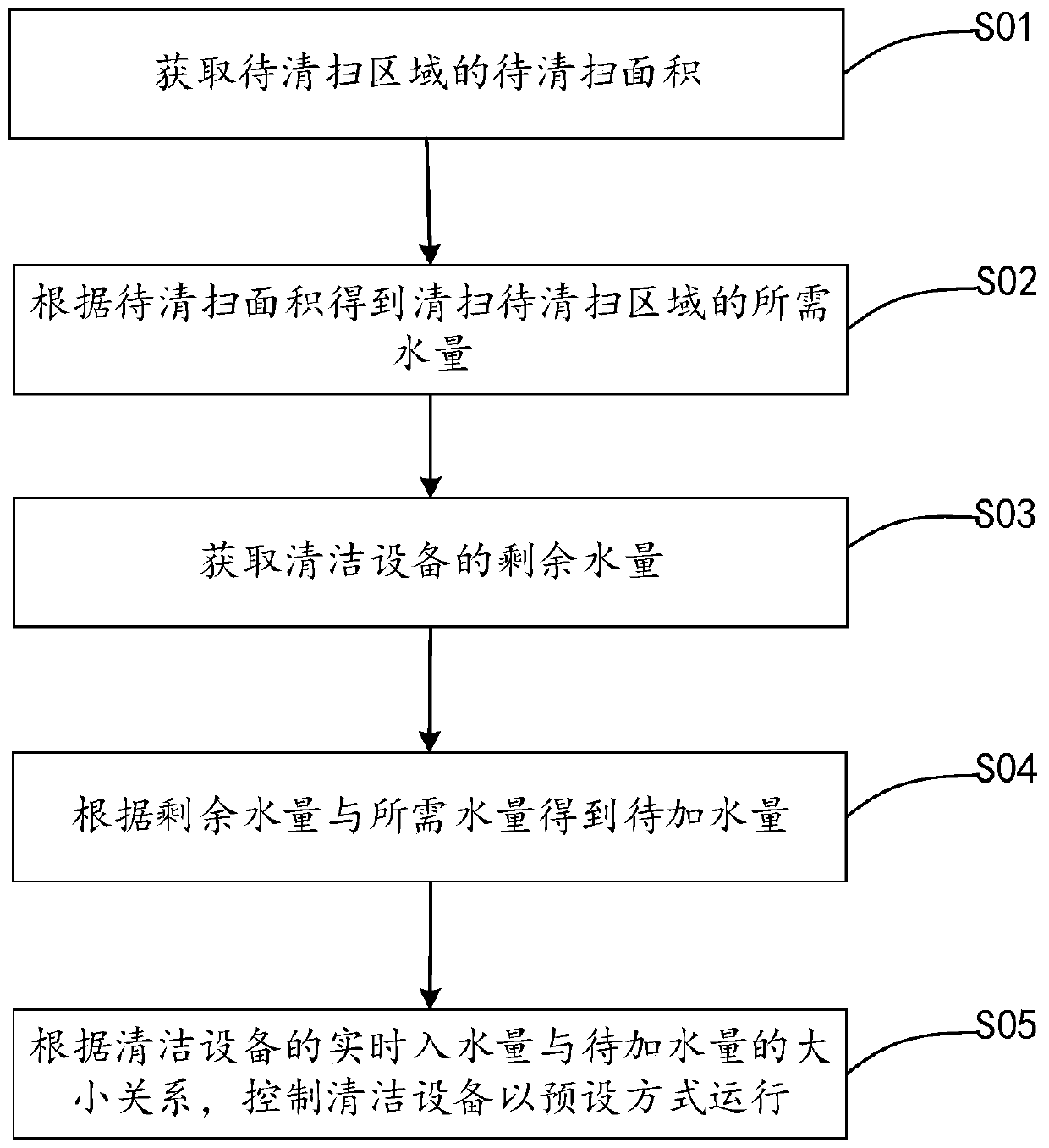Control method of cleaning device and cleaning device
A technology for cleaning equipment and control methods, which is applied in the field of cleaning equipment and cleaning equipment control, and can solve problems such as the difficulty in controlling the amount of added water, so as to improve user experience and prevent the effect of adding too much or too little water
- Summary
- Abstract
- Description
- Claims
- Application Information
AI Technical Summary
Problems solved by technology
Method used
Image
Examples
Embodiment 1
[0025] see figure 1 , the control method of the cleaning equipment of the embodiment of the present invention, the control method includes the steps of:
[0026] S01: Obtain the area to be cleaned in the area to be cleaned;
[0027] S02: Obtain the required water volume for cleaning the area to be cleaned according to the area to be cleaned;
[0028] S03: Obtain the remaining water volume of the cleaning equipment;
[0029] S04: Obtain the amount of water to be added according to the remaining water amount and the required water amount; and
[0030] S05: According to the relationship between the real-time water input of the cleaning equipment and the amount of water to be added, control the cleaning equipment to operate in a preset manner.
[0031] In the embodiment of the present invention, the cleaning device can obtain the required amount of water according to the area to be cleaned in the area to be cleaned, and then obtain the amount of water to be added according to ...
Embodiment 2
[0046] see figure 2 , further, the cleaning device includes a first prompter, step S05 includes:
[0047] S051: When the real-time water intake reaches the amount of water to be added, control the first prompter to send a first prompt signal indicating that the real-time water intake has reached the amount of water to be added.
[0048] Specifically, when the real-time water intake reaches the amount of water to be added, that is, when the amount of water added to the cleaning device is the same as the amount of water to be added, the cleaning device can send out a first reminder signal representing that the real-time water intake reaches the amount of water to be added through the first prompter , to inform the user that the value of the real-time water input of the current cleaning equipment is equal to the value of the water to be added. When the user obtains the first prompt signal, stop adding water to the cleaning equipment in time, so as to avoid excessive water added ...
Embodiment 3
[0058] see image 3 , further, the cleaning equipment includes a first water inlet for entering water, step S05 includes:
[0059] S052: When the real-time water intake reaches the water volume to be added, close the first water inlet.
[0060] Specifically, when the real-time water input reaches the amount of water to be added, that is, when the amount of water added to the cleaning device is the same as the amount of water to be added, the cleaning device closes the first water inlet, so that the user cannot continue to add water to the cleaning device, thereby avoiding Too much water was added to the cleaning equipment.
[0061] In this implementation, the cleaning device can automatically close the first water inlet when the value of the current real-time water input of the cleaning device is equal to the value of the amount of water to be added, so as to prevent the external water from continuing to enter the cleaning device, thereby avoiding the cleaning device. Added ...
PUM
 Login to View More
Login to View More Abstract
Description
Claims
Application Information
 Login to View More
Login to View More - R&D
- Intellectual Property
- Life Sciences
- Materials
- Tech Scout
- Unparalleled Data Quality
- Higher Quality Content
- 60% Fewer Hallucinations
Browse by: Latest US Patents, China's latest patents, Technical Efficacy Thesaurus, Application Domain, Technology Topic, Popular Technical Reports.
© 2025 PatSnap. All rights reserved.Legal|Privacy policy|Modern Slavery Act Transparency Statement|Sitemap|About US| Contact US: help@patsnap.com



